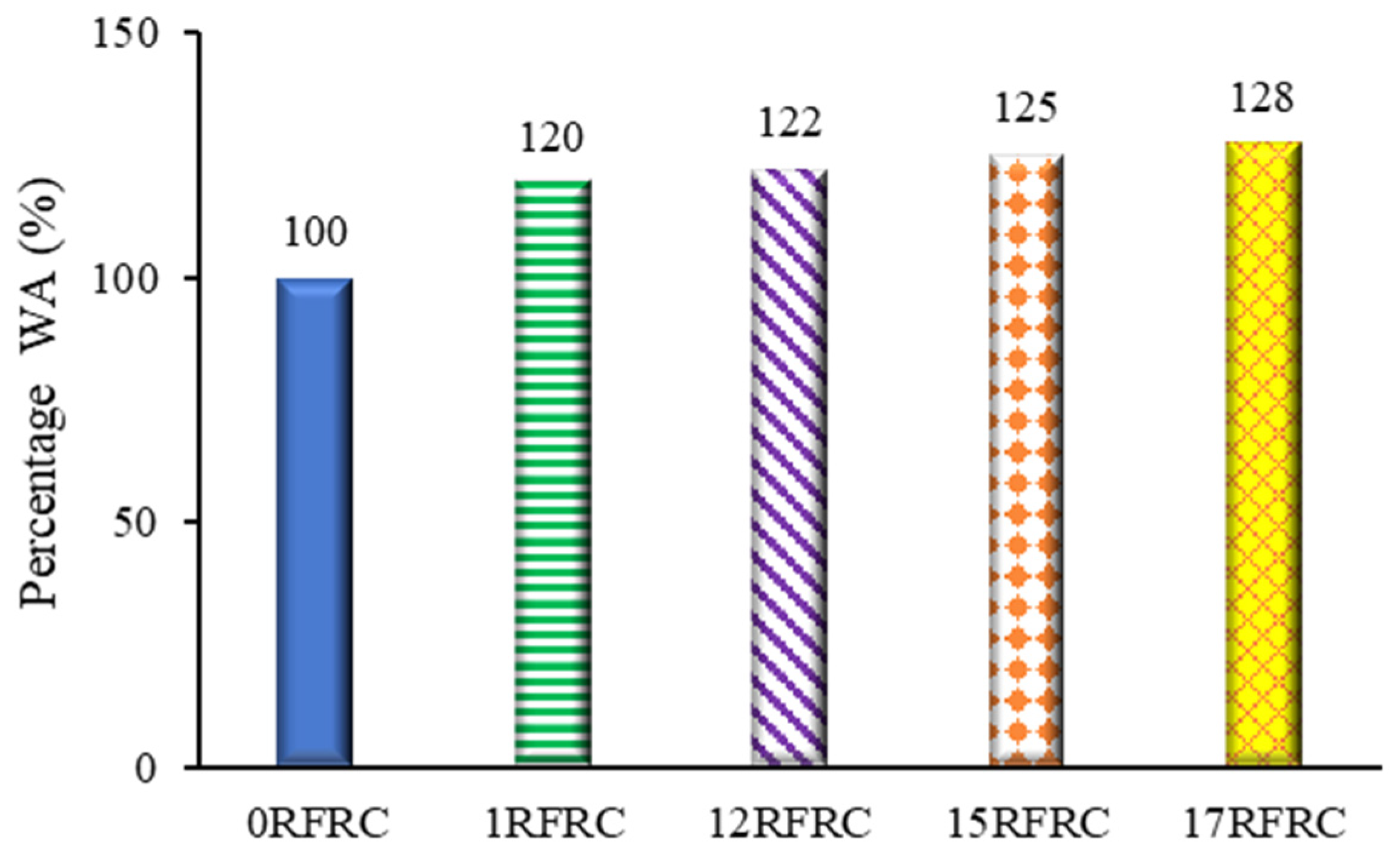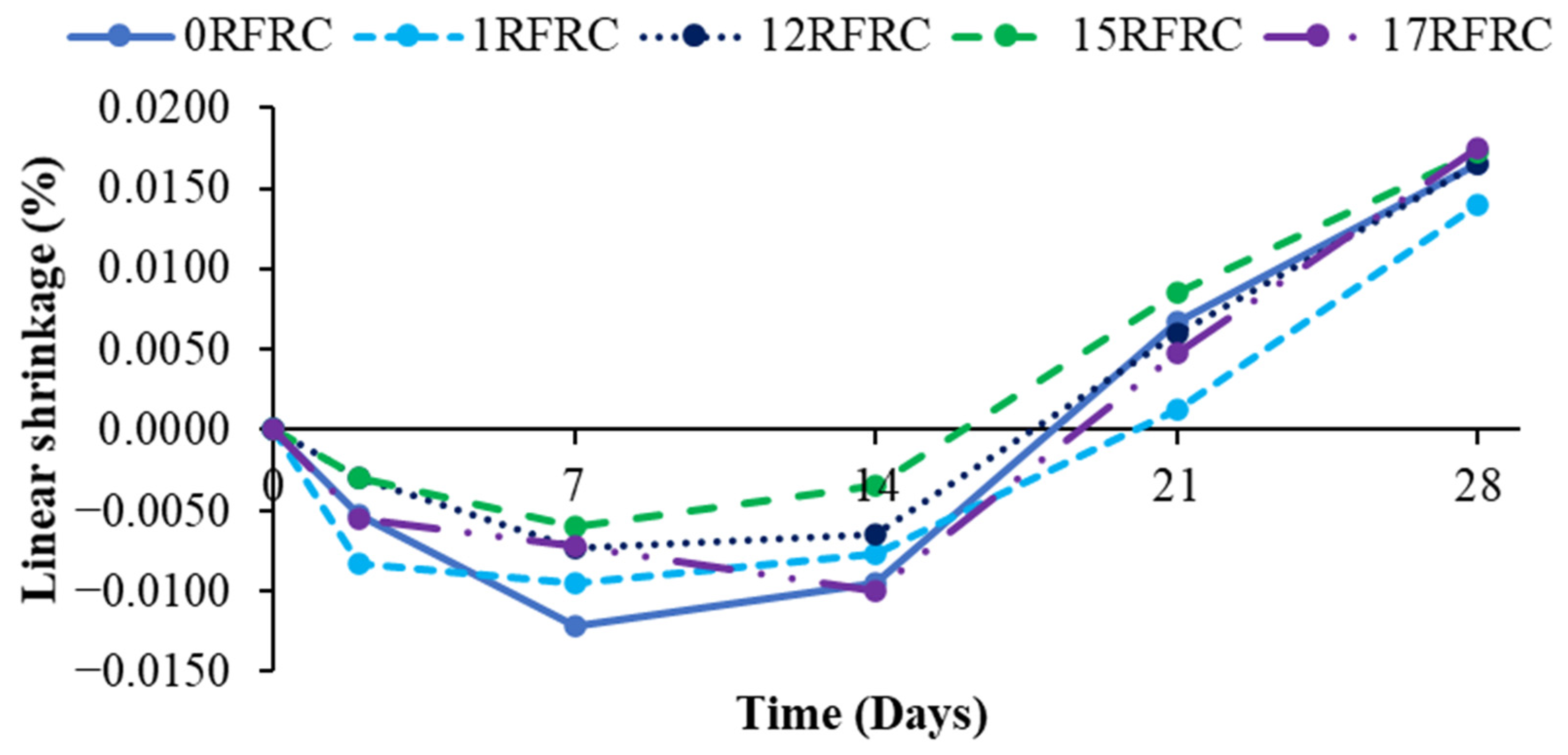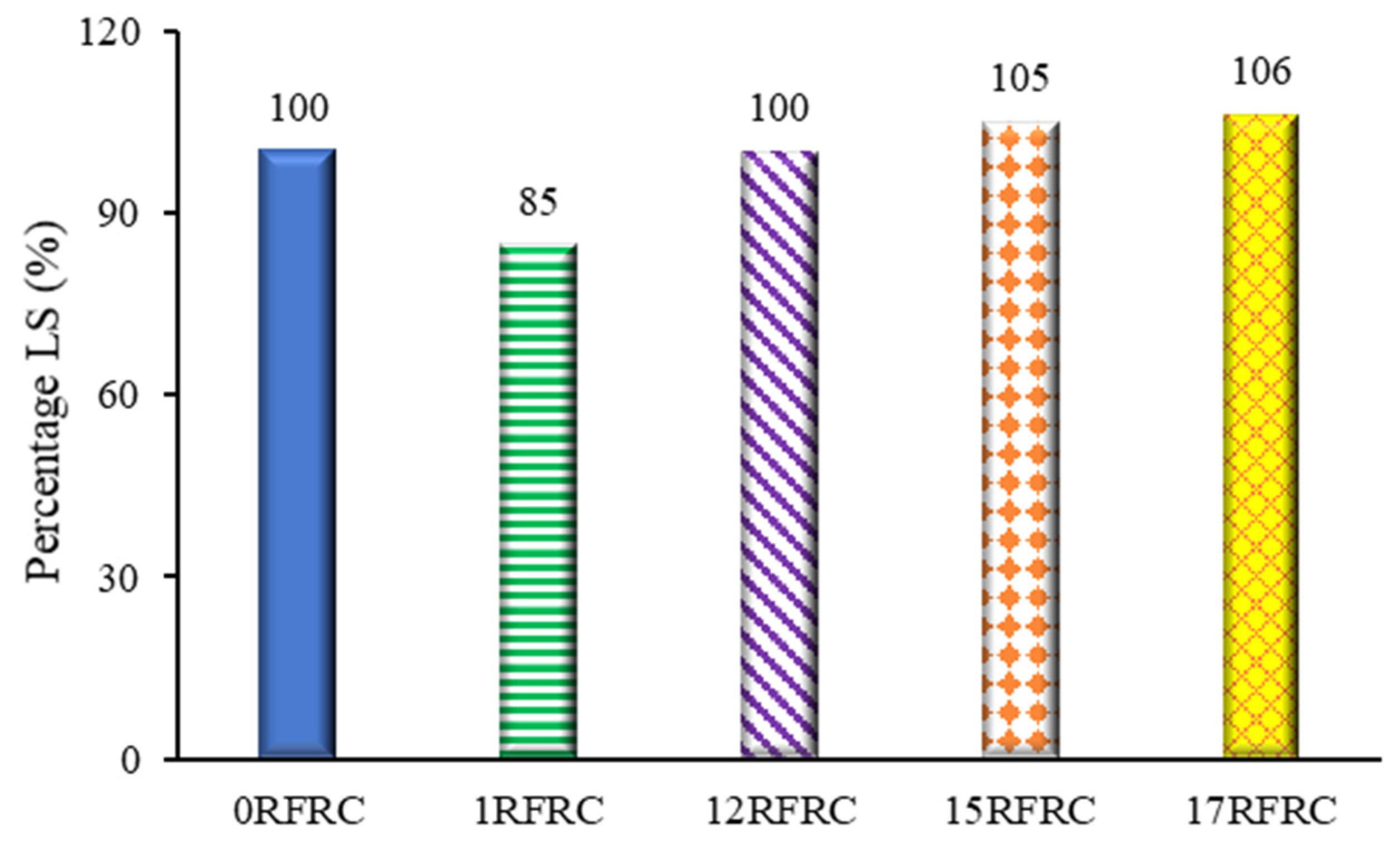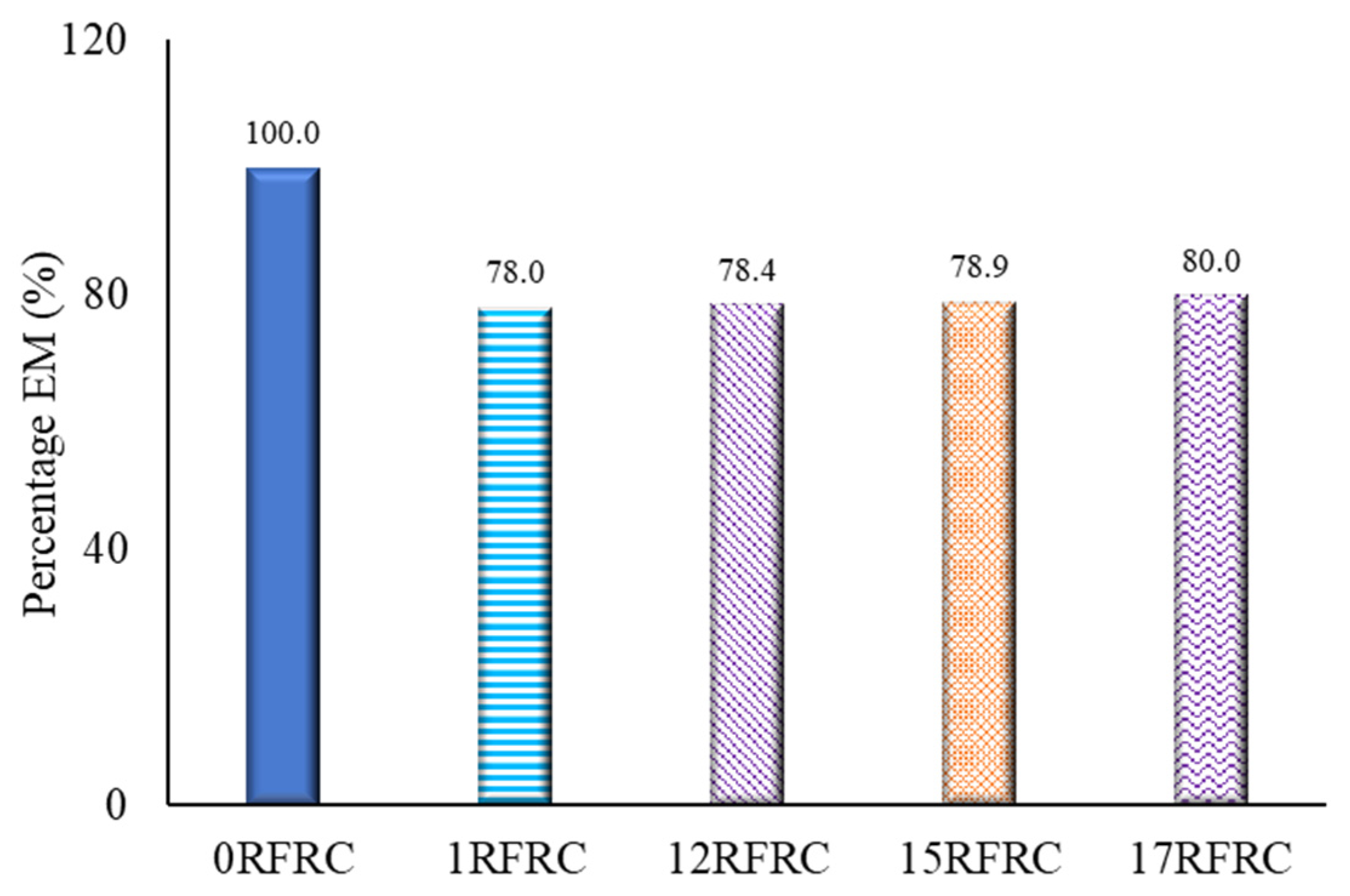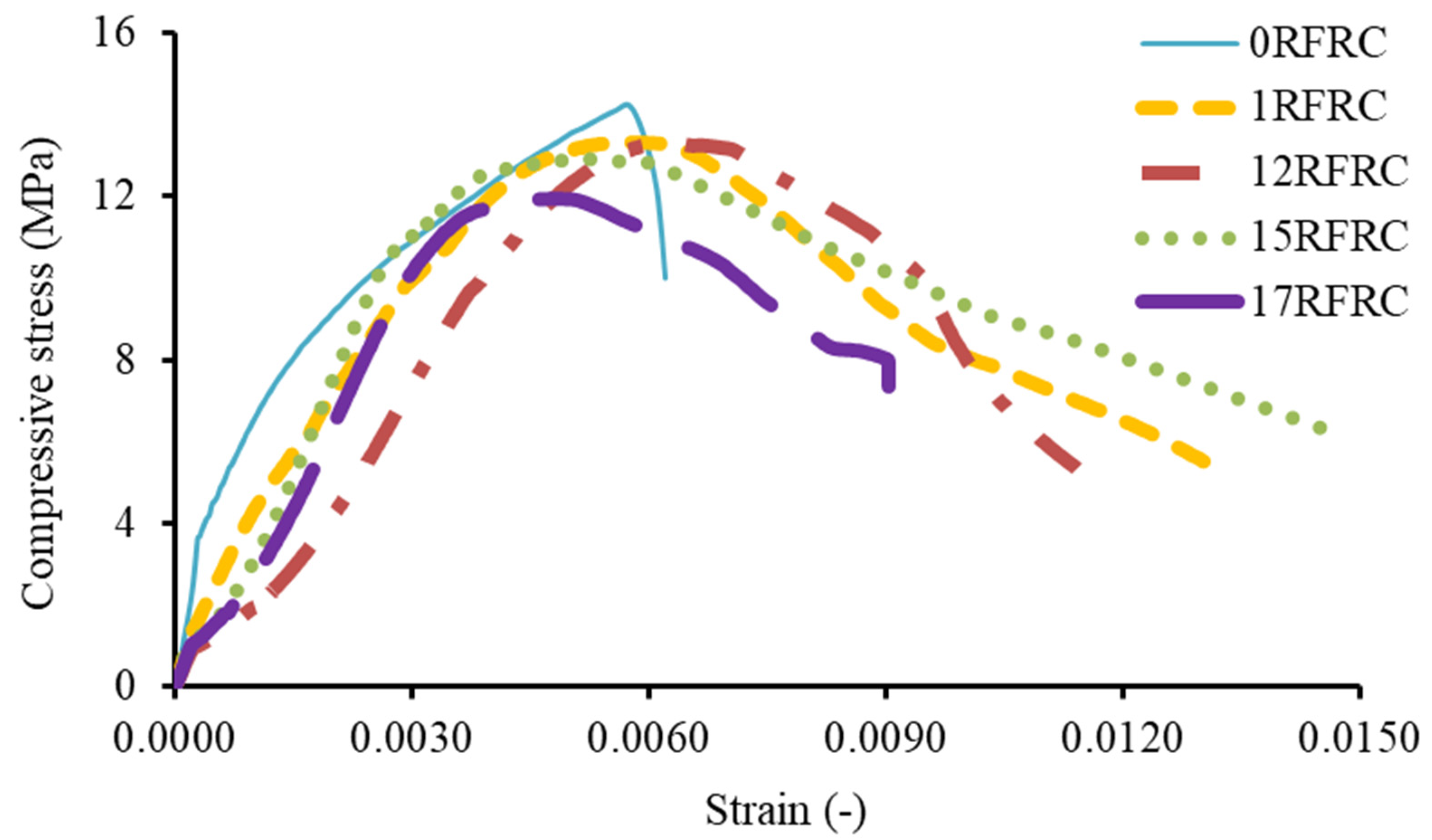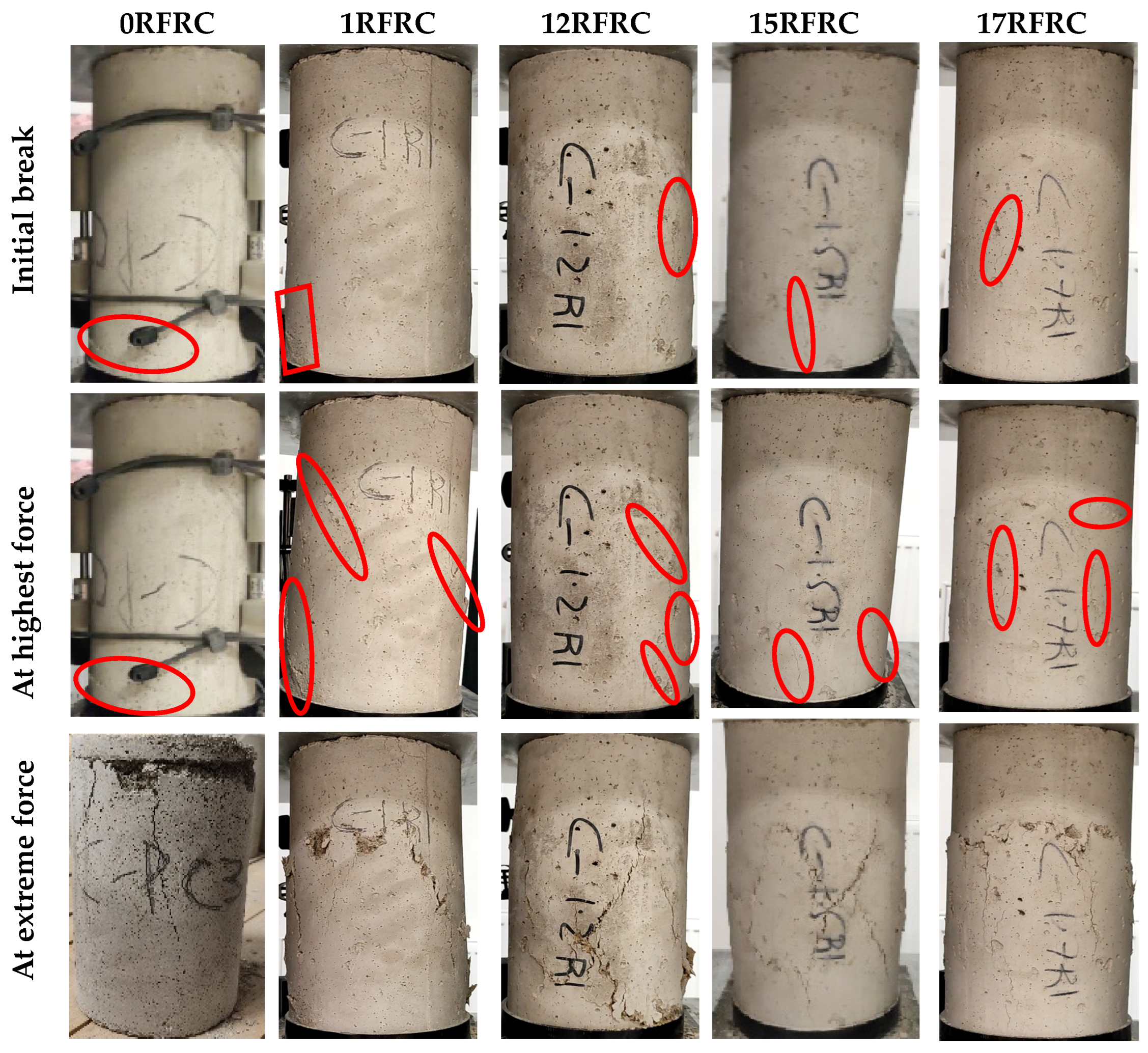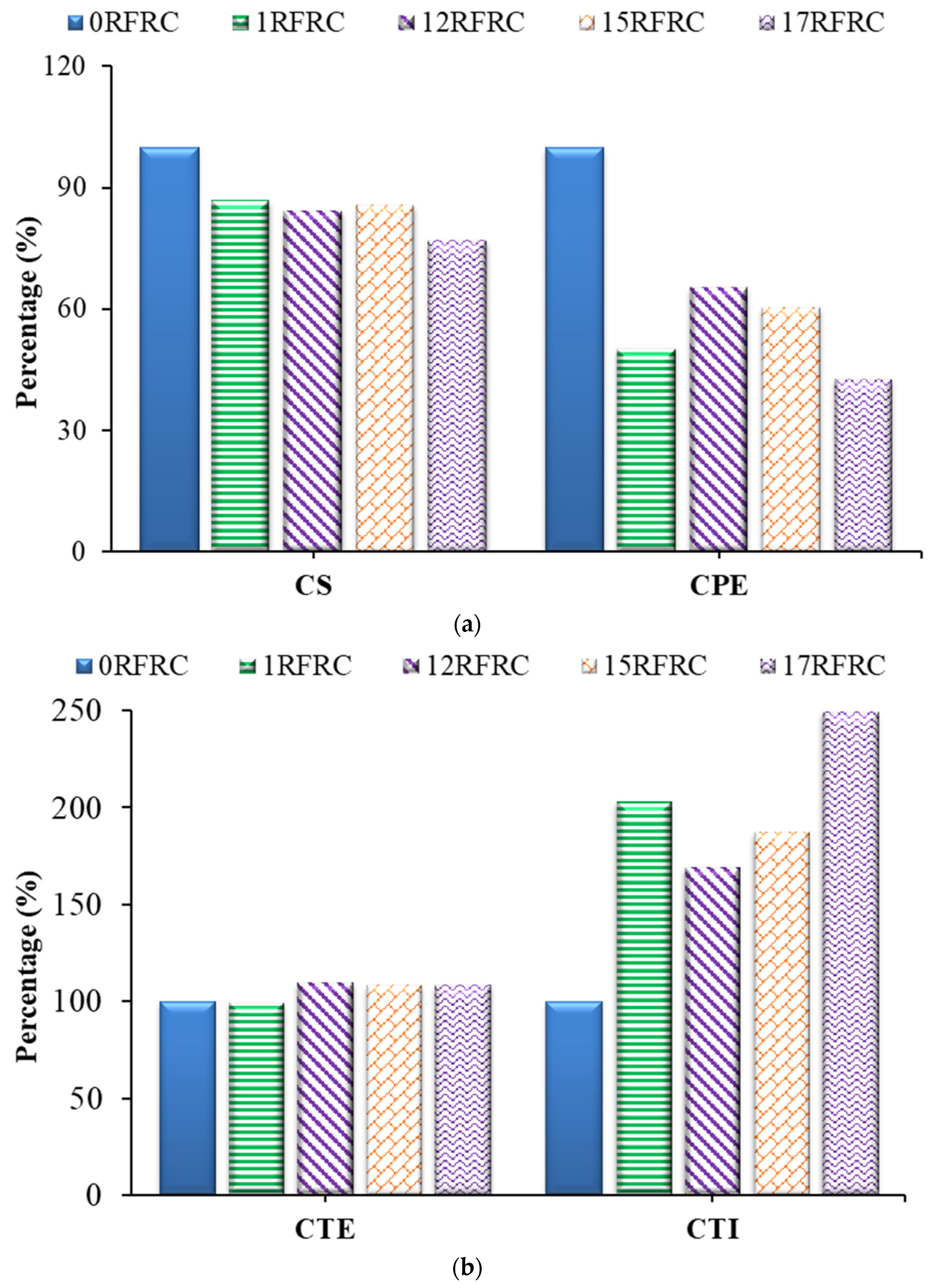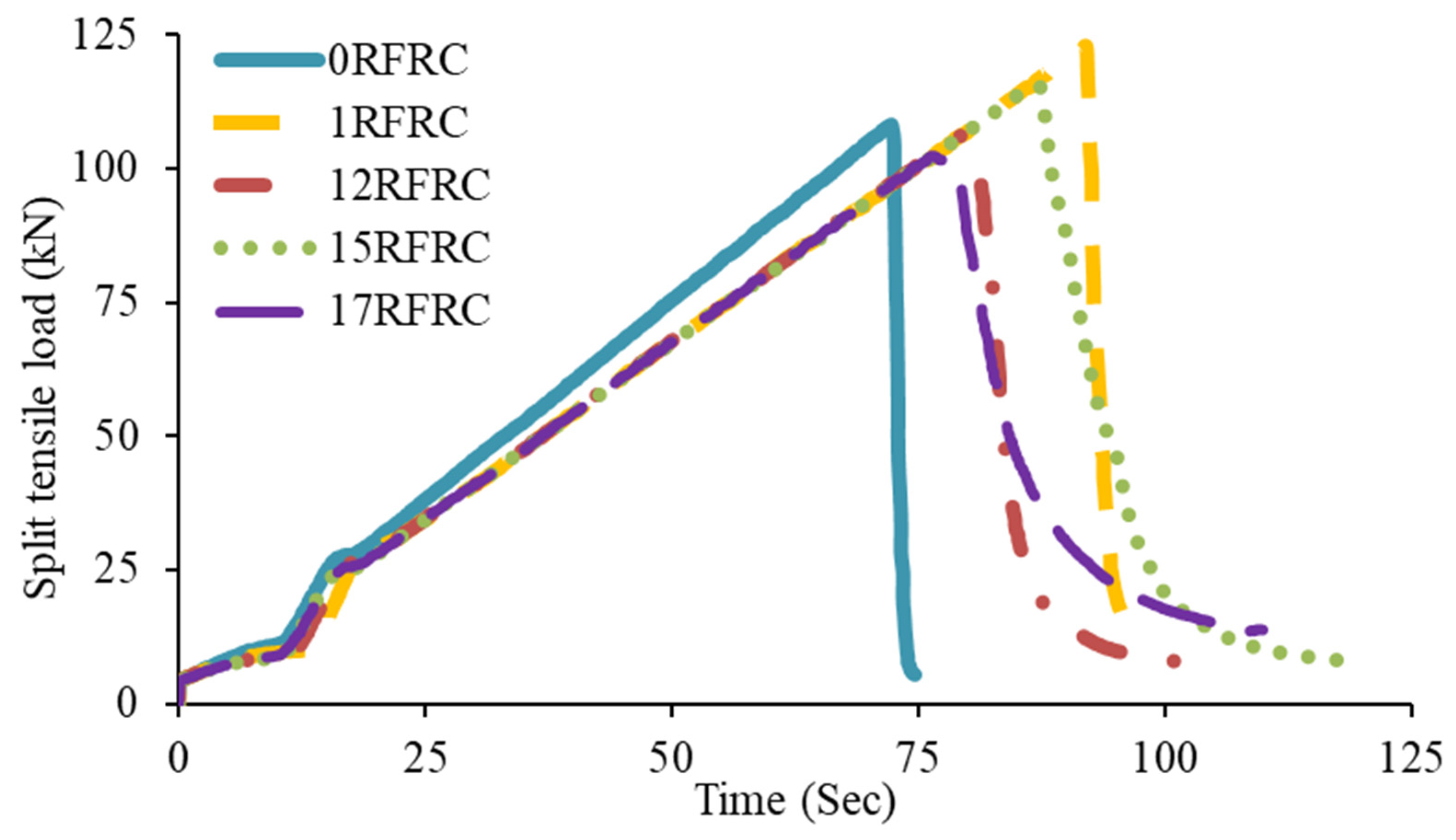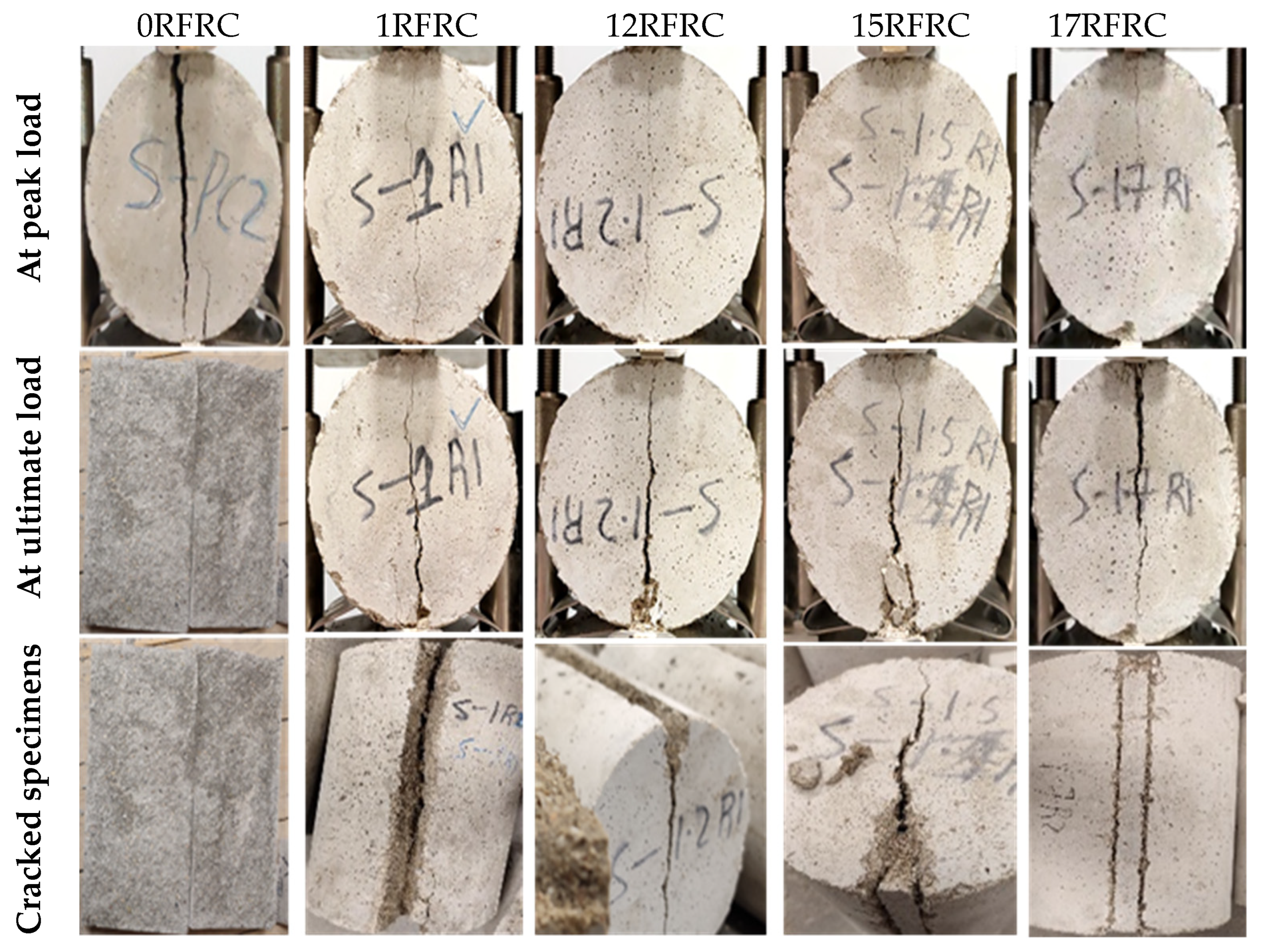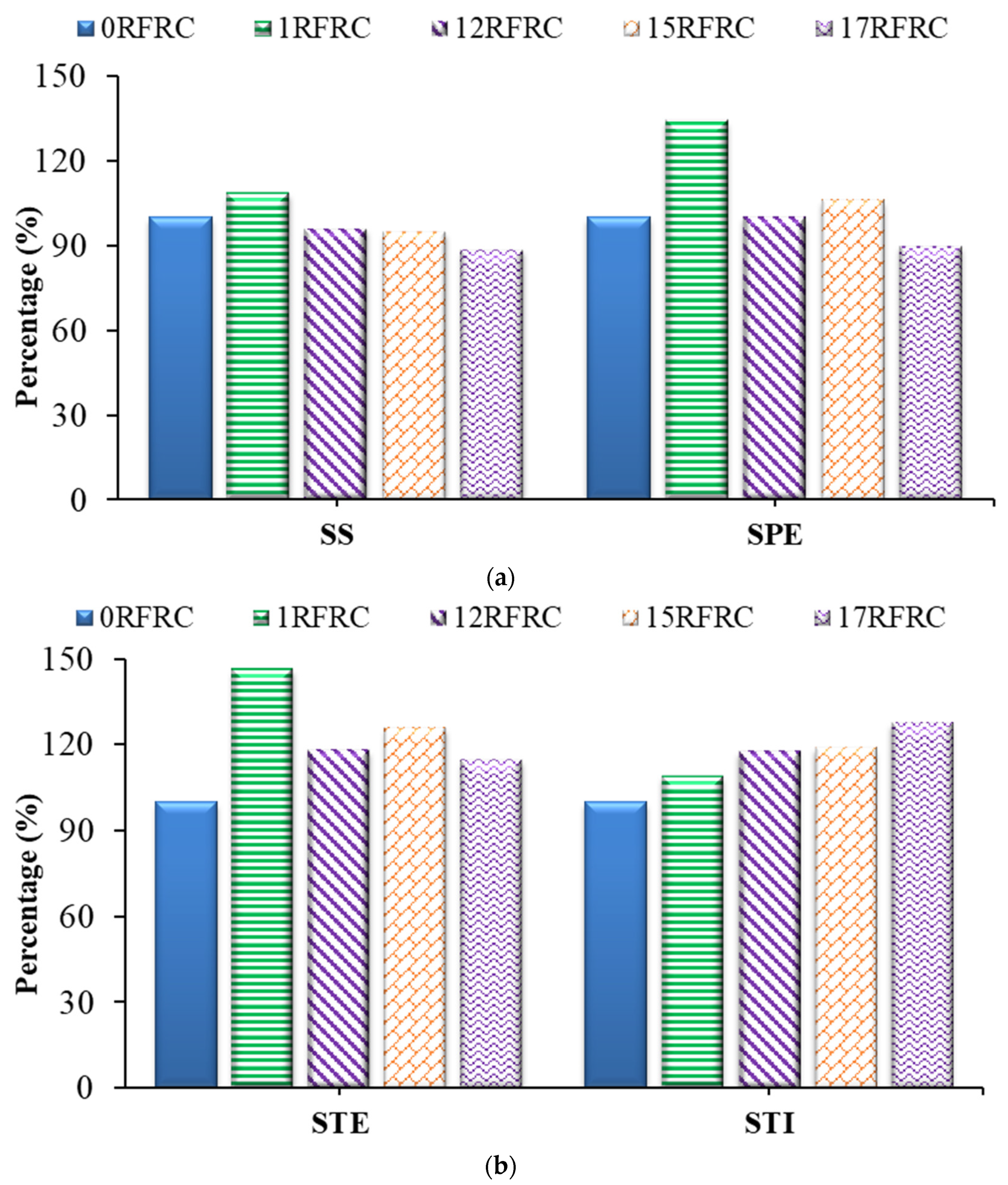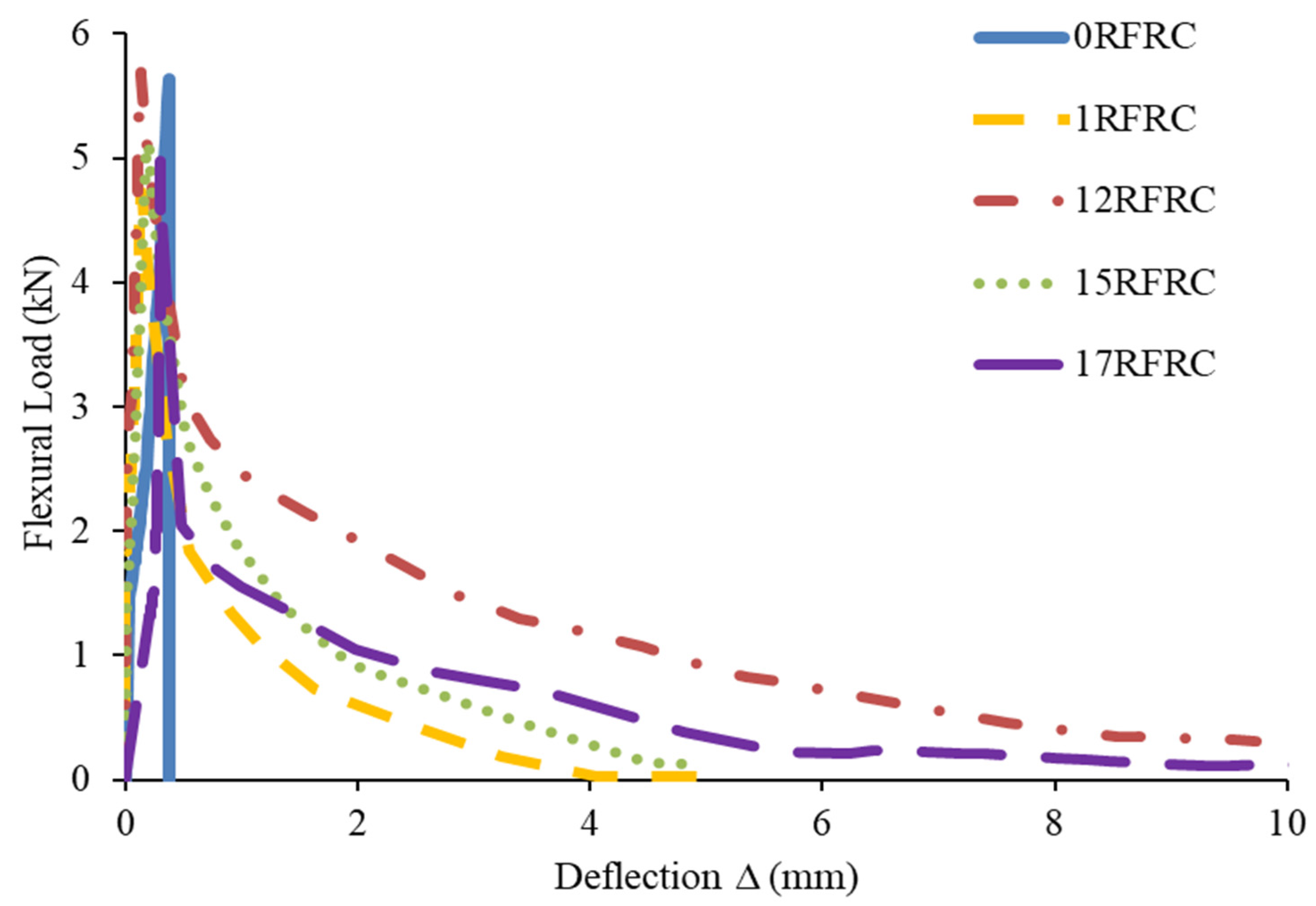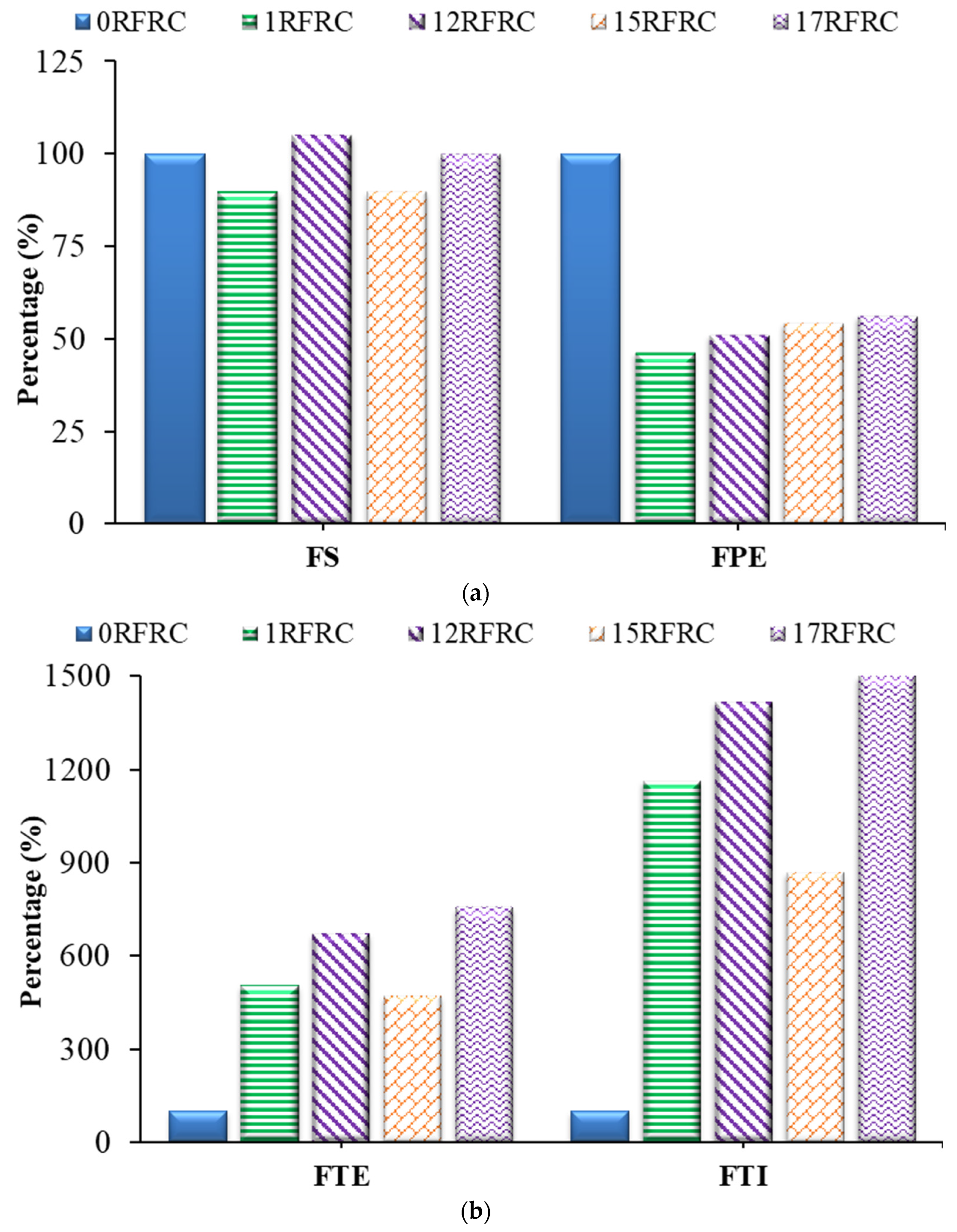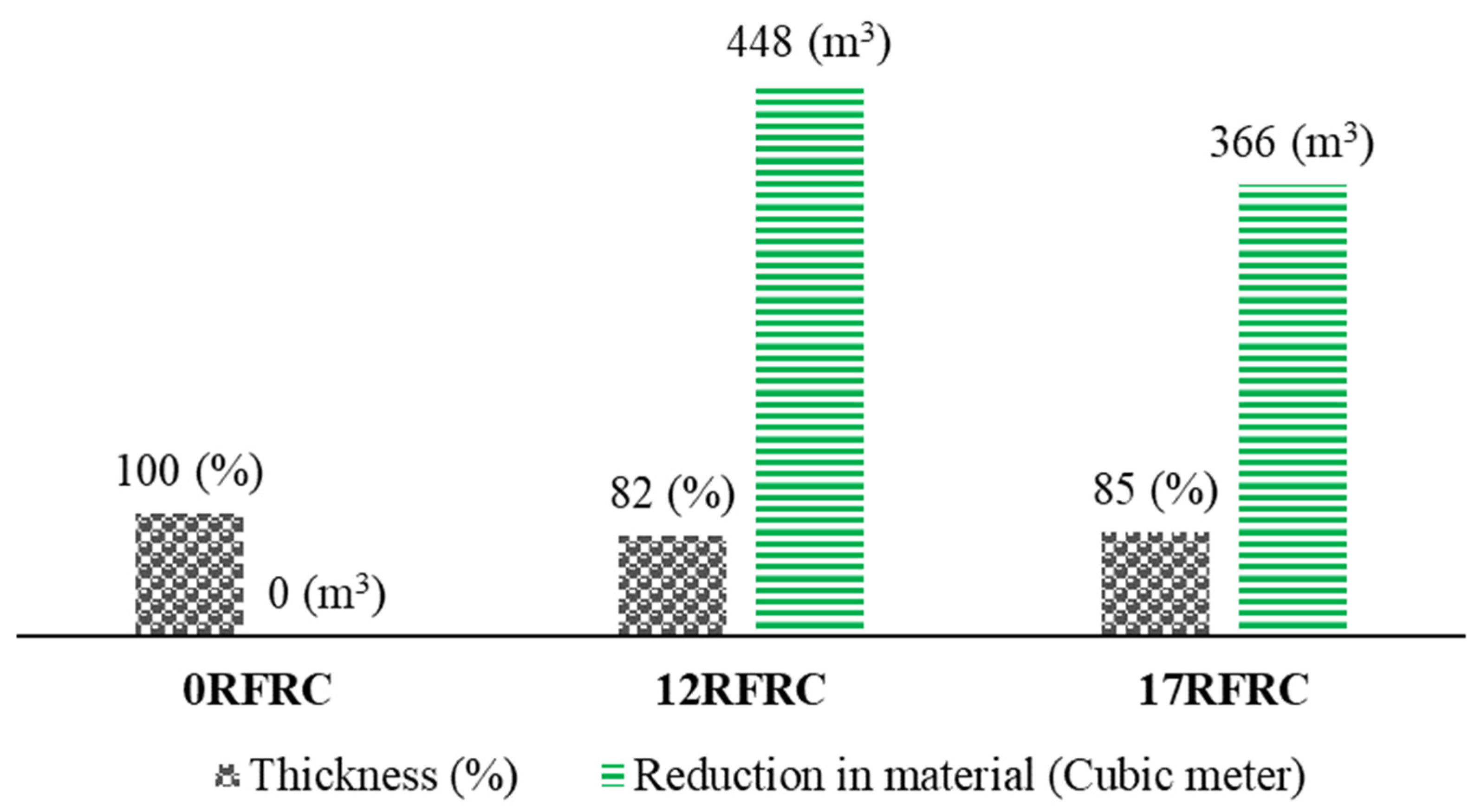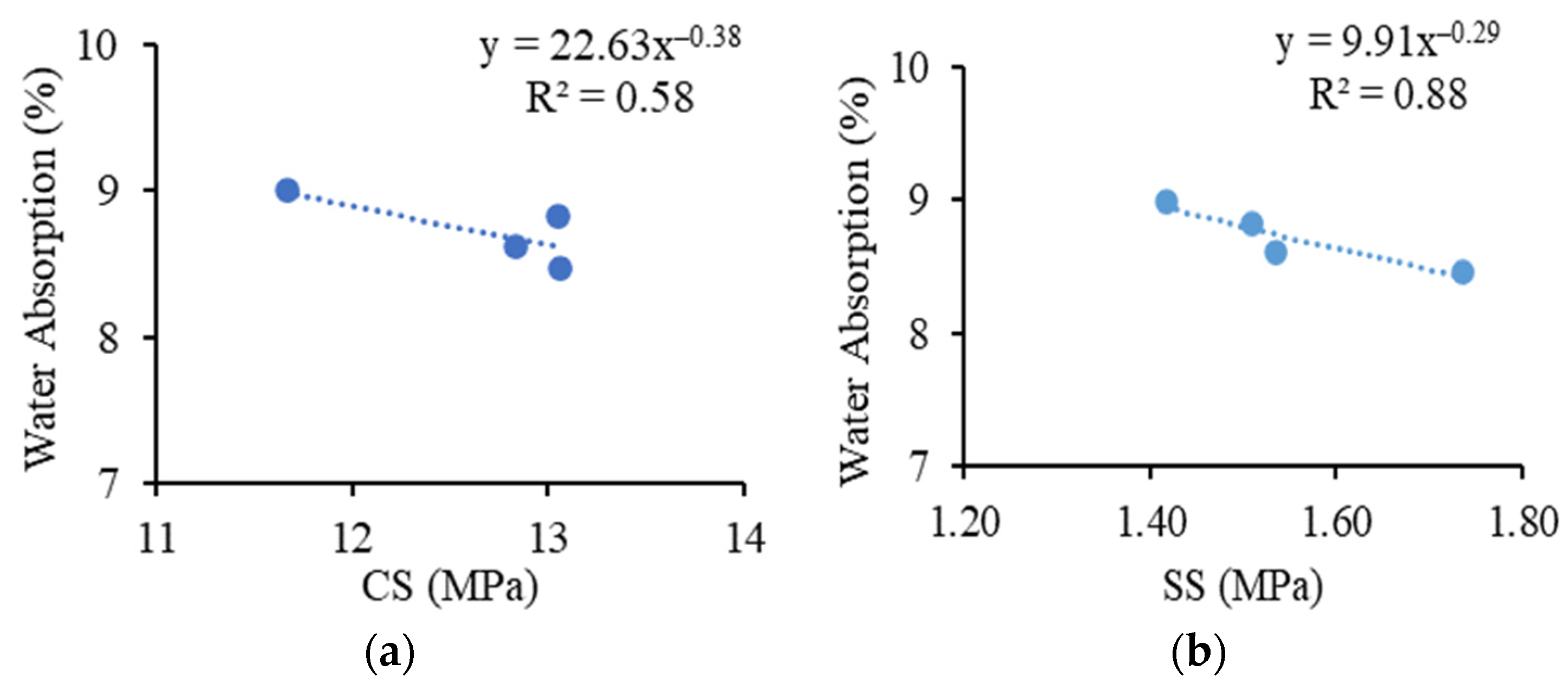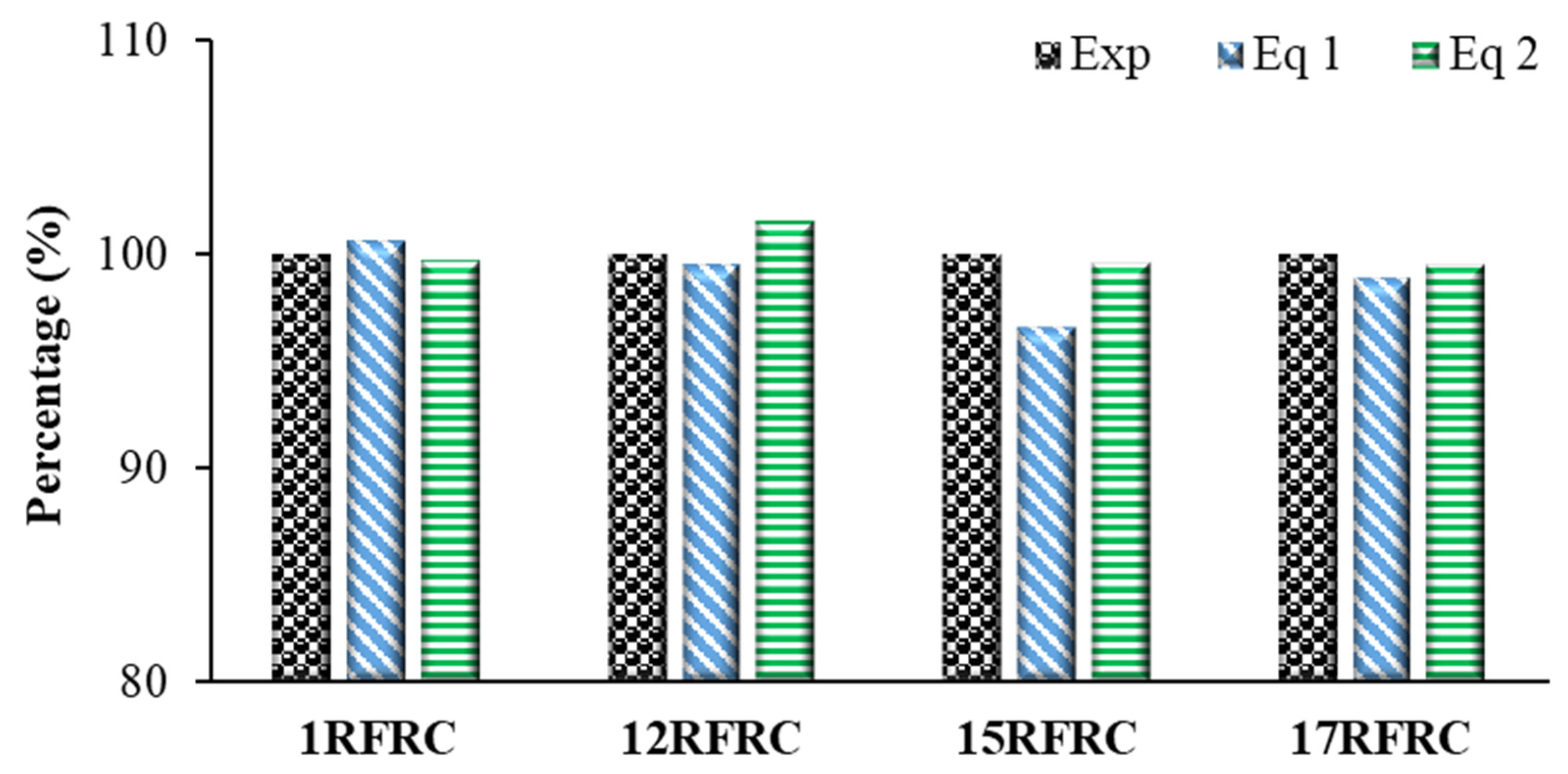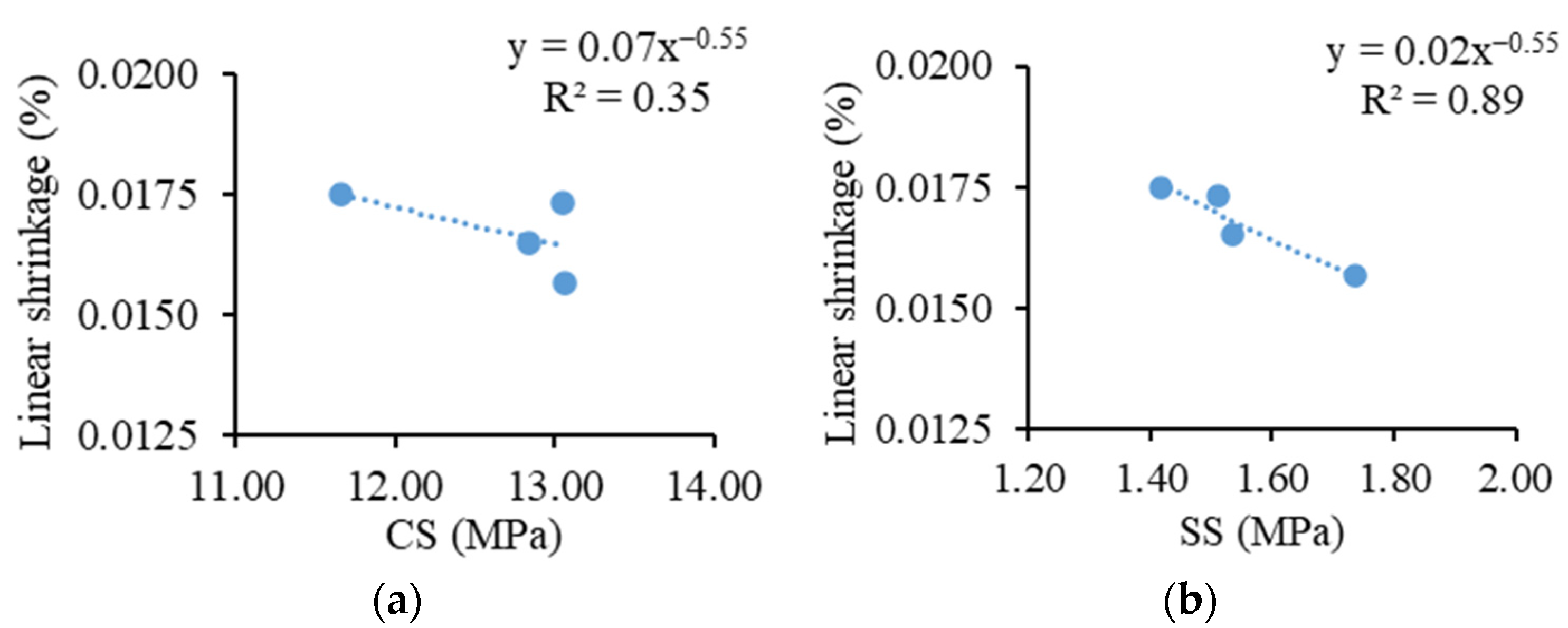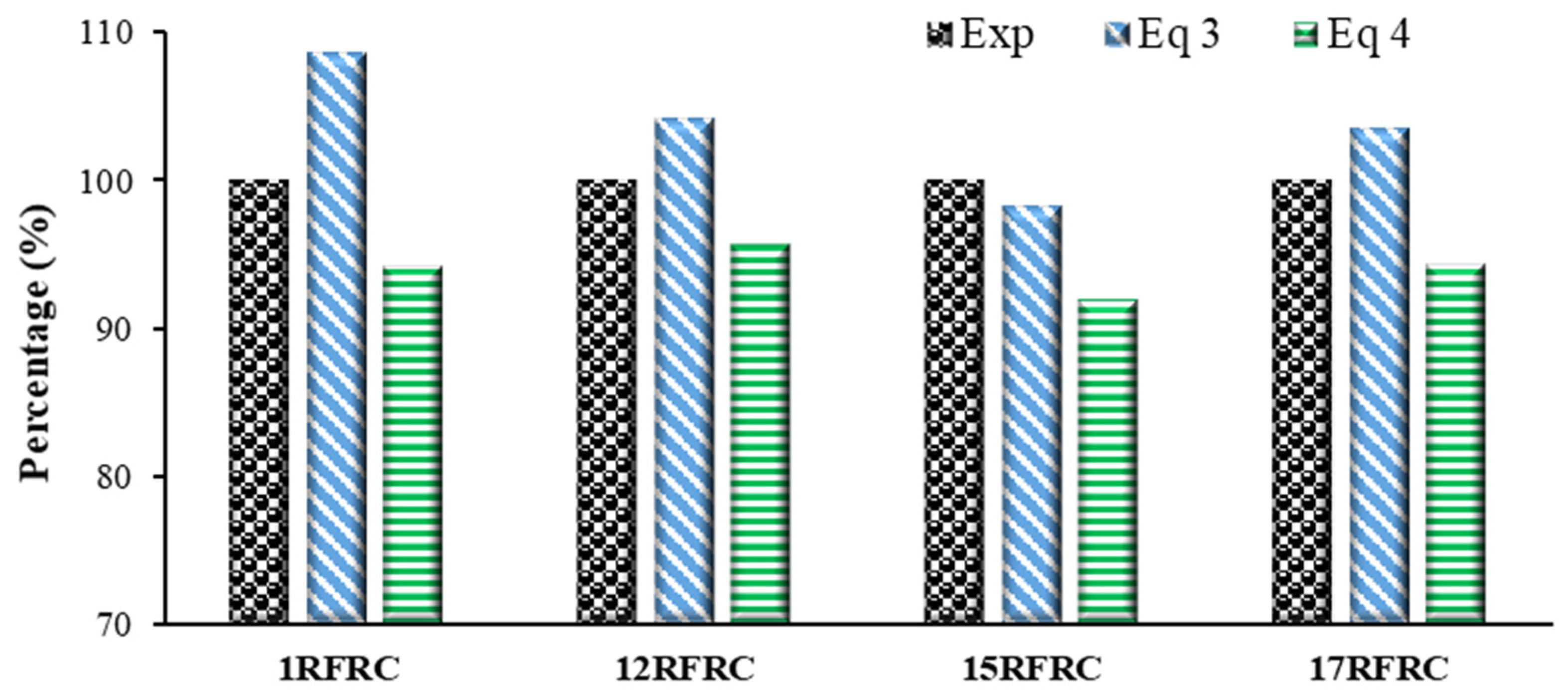1. Introduction
One of the primary objectives of the United Nations is to promote environmental sustainability through waste recycling. However, certain waste materials pose significant challenges when transforming them into useful resources. Solid waste materials that cannot be efficiently recycled are often repurposed and incorporated into different materials and products, such as utilizing anti-stripping-treated waste ceramic in superpave asphalt mixtures [
1], silane-treated waste glass powder in concrete pavement [
2], bagasse ash in asphalt concrete pavements [
3], water treatment sludge and stone dust in concrete [
4], and recycled waste glass in ultra-high-performance concrete [
5]. One example of a major solid pollutant is discarded tires, which can take up to 100 years to degrade when exposed to the open air [
6,
7,
8]. Therefore, finding effective techniques to reuse and repurpose waste tires and their components is paramount.
Considerable research has been dedicated to the reuse and recycling of rubber obtained from discarded tires [
9]. In Europe, an optimized approach to managing used tires, based on the principle of extended producer responsibility, has gained popularity for its effectiveness [
10]. Although the recovery rate for scrap tires in Europe and the United States is approximately 90% [
11], it is predicted that by 2030, there will be up to 5 billion end-of-life tires (ELTs) in landfills and stockpiles globally [
12]. It was estimated that China alone would produce 20 million metric tons of tires in 2020 [
13]. Hence, other industries, including the construction sector, must contribute to the utilization of discarded tires.
The European Tyre and Rubber Manufacturers’ Association (ETRMA) stated that the burden of waste tires is increasing in Slovakia, where no waste tires are currently being used for backfilling, public works, or civil engineering purposes [
14]. The amount of steel fiber that can be recovered from waste tires varies depending on the type of tire, with steel accounting for approximately 10–15% of lightweight vehicles and 21–25% of trucks [
12,
15]. Steel cords and fibers constitute the third-largest component by weight in a tire, making up 15–17 percent of its total weight [
16].
Various studies have explored the use of different types of fibers to enhance the mechanical properties of cement composites. However, industrial fibers of all types come at a cost, with natural fibers generally being more affordable than their industrial counterparts. For instance, the incorporation of natural fibers like jute and wheat straw fibers has been shown to improve the mechanical properties of concrete [
17,
18,
19]. However, natural fibers have limitations in terms of biodegradability, bond strength with concrete, and decomposition over time. In some cases, additional treatments are required to improve the bond between natural fibers and cement composites, as demonstrated by Farooqi and Ali’s study on pre-treated wheat straw fibers [
20].
Furthermore, chemical treatments can enhance the bond between natural fibers and cement composites in the short term but may negatively impact the long-term performance of the fibers. Natural fibers, such as jute and wheat straw fibers, also tend to absorb water, which can accelerate their degradation and lead to water seepage in concrete [
17,
18]. Similarly, studies involving coconut fibers (shell and husk) have shown high water absorption compared to plastic or steel fibers [
21,
22,
23]. On the other hand, natural resources are also depleting and come at a cost now; hence, natural fibers also have considerable cost, and additional treatment required for increasing their bond and other properties enhances their cost further. Therefore, natural fibers may not always be the optimal choice for achieving reliable long-term results compared to non-biodegradable fibers.
On the other hand, certain artificial fibers, like glass fibers, are not chemically stable when in contact with cement and other chemicals. By replacing industrially produced steel or other types of fibers with waste fibers obtained from discarded tires, energy consumption, greenhouse gas emissions, and costs can be reduced [
24]. Qin and Kaewunruen [
25] stated that the average cost of industrial steel fibers (ISF) is over five times that of recycled waste tire steel fibers (RSFs). The results show that using RSF replacements for ISF has a considerable positive impact on the economy and the environment. Additionally, the social function of RSF cannot be disregarded. Waste tires (and their components) cause severe environmental issues [
26,
27]. The RSF performs equally to the ISF in improving concrete split and flexure strengths, according to a previous study [
28,
29]. A comprehensive review by Zia et al. [
30] further supports the potential use of RSFs in cement composites, highlighting significant enhancements in mechanical strengths.
However, it is worth noting that the available database of experimental studies related to RSF-incorporated concrete (RFRC) is still insufficient to draw conclusive findings regarding the optimal content of RSFs for desired characteristics [
31,
32,
33,
34,
35]. Particularly, the majority of investigations [
36,
37,
38,
39] lack the experimental evaluation of RFRC for linear shrinkage and water absorption, thus neglecting the essential aspect of RFRC’s durability. Therefore, there is a need to extensively test the mechanical and durability properties of RFRC to enhance the existing experimental database. Furthermore, the literature review indicates a lack of information on energy absorption and toughness of RFRC for all mechanical strengths. Consequently, various properties and aspects are missing in the current studies regarding the experimental properties of RSF-reinforced concrete, as shown in
Table 1. The strength properties of RSFRCs have indeed been evaluated in the previous studies, but as per the limited literature review of the authors, the mechanical strengths, elastic modulus, capacity to absorb water, and linear shrinkage have not all been reported so far for the same mix and concrete type in one study. In addition, the influence of high doses of RSFs on the concrete properties has also not been explored extensively. Gul et al. [
40] investigated the properties of concrete incorporating meticulously selected RSFs, measuring 100 mm in length and 0.939 mm in thickness. However, this study did not provide data on essential characteristics such as the elastic modulus (EM), water absorption (WA), and linear shrinkage (LS). Similarly, Rossli and Ibrahim [
36] explored the effects of RSFs with dimensions of 60 mm in length and 0.80 mm in thickness on various mechanical properties.
Nevertheless, this research did not report critical parameters like EM, WA, and LS. In the work of Leone et al. [
41], concrete containing a low percentage of raw RSFs (ranging from 0.3% to 0.46% by volume of concrete) exhibited a noTable 10% decrease in compressive strength (CS) and a 3% reduction in split tensile strength (SS). However, critical properties such as bending strength (BS), EM, WA, and LS were not subject to assessment. Caggiano et al. [
42] delved into the influence of RSFs measuring 26.17 mm in length and 0.25 mm in thickness on concrete properties. While their study revealed a 3% decrease in CS, data pertaining to significant attributes including EM, SS, WA, and LS, were not included. Pawelska-Mazur and Kaszynska [
24] and Samarakoon et al. [
43] both explored the potential of raw RSFs to enhance concrete properties. However, their assessments did not address crucial factors such as EM, WA, and LS. Among the limited existing studies, Skarżyński and Suchorzewski [
44] and Zia et al. [
45] stand out as the sole research efforts that examined the impact of 0.50% to 0.75% of raw RSFs on concrete linear shrinkage (LS). The findings of Skarżyński and Suchorzewski [
44] indicated an increase in LS attributed to the incorporation of RSFs.
In contrast, Zia et al. [
45] reported a decrease in LS at an RSF dosage of 0.75%, but they observed an increasing trend in LS with a gradual rise in RSF dosage. Nevertheless, further research is essential to validate the definitive influence of raw RSFs on controlling LS. It is also noteworthy that the investigation of water absorption (WA) is a relatively rare occurrence within the available database, with only a few studies, including those by Shah et al. [
46] and Akhtar et al. [
47], exploring this characteristic.
Furthermore, the majority of the studies in this field have predominantly investigated the influence of low dosages of RSFs. For instance, Rossli and Ibrahim [
36] employed RSFs in concentrations ranging from 0.20% to 1% by volume of concrete, Leone et al. [
41] used 0.46%, Caggiano et al. [
42] 0.75%, Vistos et al. [
28] 0.50%, Samarakoon et al. [
43] examined 0.50% and 1%, Skarżyński and Suchorzewski [
44] investigated 0.50%, Aiello et al. [
48] considered dosages between 0.13% to 0.26%, Chen et al. [
37] explored the range from 0.50% to 1.25%, and Dorr et al. [
49] studied the effect of 0.50% RSFs. Hence, there exists a critical need to comprehensively evaluate the effectiveness of high doses of RSFs to determine their potential implications on the behavior of concrete.
Moreover, it is crucial to underscore that the majority of existing studies have focused on the influence of RSFs in a meticulously separated and purified form. However, commercially available RSFs are typically presented in a raw state, characterized by varying sizes and the presence of a minute rubber content. This divergence emphasizes the utmost significance of assessing the impact of RSFs on a comprehensive range of mechanical properties and durability-defining attributes, including LS and WA, within the context of the same concrete type.
To address this gap, the current research goal is to assess the strength and durability characteristics of RSF concrete (RFRC). Different dosages of RSFs are examined using locally available materials, including RSFs and the local concrete C20/25 from Bratislava, Slovakia. This study is part of an extensive experimental program where high quantities of RSFs, extending from 1% to 1.75% by concrete volume, are included. Approximately one percent of polyester, small steel fibers, and rubber fragments were included in the mix of the fibers used in this study. The mechanical properties, such as the elastic modulus, compressive strength, split tensile strength, and flexural strength, are thoroughly evaluated. Additionally, parameters such as densities, slumps, energy absorption, toughness, capacity to absorb water by immersion, and change in length due to shrinkage are measured as well.
Table 1.
Missing properties in the previous studies.
Table 1.
Missing properties in the previous studies.
| Authors | Missing in the Previous Studies |
|---|
| Strength Properties | Other Properties |
|---|
| Gul et al. [40] | EM | WA, LS |
| Rossli and Ibrahim [36] | EM | WA, LS |
| Leone et al. [41] | EM, BS | WA, LS |
| Caggiano et al. [42] | EM, SS | WA, LS |
| Pawelska-Mazur and Kaszynska [24] | EM, BS | WA, LS |
| Samarakoon et al. [43] | EM | WA, LS |
| Skarżyński and Suchorzewski [44] | EM | WA |
| Aiello et al. [48] | EM, BS | WA, LS |
| Chen et al. [37] | EM, SS, BS | WA, LS |
| Shah et al. [46] | EM, SS | LS |
| Siraj and Kedir [50] | SS, EM | WA, LS |
| Köroğlu [51] | EM | WA, LS |
| Abdul Awal et al. [52] | EM | WA, LS |
| Centonze et al. [53] | EM, SS, BS | WA, LS |
| Akhtar et al. [47] | EM | LS |
| Younis [54] | EM | WA, LS |
| Suleman et al. [55] | EM, SS | WA, LS |
| Peng et al. [56] | EM, BS | WA, LS |
2. Research Gap
The existing literature on recycled tire steel fiber-reinforced concrete (RFRC) fails to provide adequate support for practical applications of RFRC within the construction industry. Many critical aspects of RFRC experimental testing remain unexplored. These include evaluating the modulus of elasticity, assessing durability-related properties such as shrinkage and water absorption, and understanding how high percentages of RSFs affect energy absorption and post-crack behavior. The current database lacks the essential information required to determine the optimized content of RSFs for specific civil engineering applications. Furthermore, evaluating locally available RSFs from Bratislava, Slovakia, is essential to promote their effective utilization in concrete at the local level. To address these research gaps, this study aims to:
Evaluate strength properties: conduct comprehensive assessments of the strength characteristics of concrete containing high volumes of recycled tire steel fibers (RSFs) to enhance the understanding of its mechanical behavior.
Analyze durability-defining properties: investigate crucial durability parameters, such as shrinkage and water absorption, to comprehend how RSFs impact the durability of RFRC.
Assess energy absorption: study the capacity of RFRC to absorb energy and its toughness characteristics, particularly when incorporating more than 1% RSFs by volume fraction.
Enhance sustainability: explore the effectiveness of RSFs in improving the sustainability of reduced-size concrete pavements.
By expanding the current database through these objectives, this research aims to provide valuable insights for future studies and engineers concerning the utilization of RSFs in concrete. This study also endeavors to enhance the understanding of the cracking behavior, toughness, and energy absorption of RFRC when incorporating high percentages of RSFs, making significant strides toward more sustainable and durable construction materials.
6. Conclusions
The experimental exploration of the impact of high percentages (ranging from 1% to 1.75%) of recycled tire steel fibers (RSF) on the strength and durability properties of concrete was a central focus of this study, driven by the goal of maximizing sustainability in concrete construction. In this research, we employed Cemix C20/25 concrete and locally sourced RSFs conforming to the EN 14889-1:2006 [
58] standard from Bratislava, Slovakia. The RSFs used in their raw state contained minor rubber pieces and polyester components. This investigation also addressed the effects of these elevated RSF doses on concrete’s strength and durability properties, presenting percentage comparisons of the properties under scrutiny. In essence, this study provides valuable insights into the application of high percentages of recycled tire steel fibers (RSFs) in concrete, shedding light on their impact across various properties related to concrete pavements and other civil engineering infrastructures.
Incorporating RSFs into concrete significantly affected workability, water absorption (WA), and linear shrinkage (LS). Notably, the workability, as measured by slump values, showed a substantial reduction. Simultaneously, the density of concrete only experienced a marginal decrease with a certain RSF content. The addition of RSFs resulted in increased WA, with the magnitude of this increase varying based on the RSF content. In contrast, LS exhibited a decreasing trend under the influence of RSFs, again with variations depending on the RSF content.
The introduction of high doses of RSFs significantly impacted mechanical properties, including the elastic modulus, compressive strength, and compressive strain. These findings indicate potential variations in concrete’s ductility and load-bearing capabilities. Further, RSFs significantly enhanced concrete’s capacity to absorb energy and toughness. The extent of these improvements varied with the specific RSF content.
Additionally, RSFs exhibited an impact on other properties like split tensile strength and flexural strength. The specific changes observed depend on the RSF content, yet they provide insights into the potential of RSFs to influence these critical mechanical attributes.
This research also highlighted the need for further study into factors like fiber diameter and impurities. The variation in RSF sizes and the presence of certain impurities, notably polyesters, influenced certain properties, emphasizing the importance of quality control in RSF usage.
Lastly, this study emphasized the cost and sustainability advantages of using RSFs in concrete pavement design. By incorporating RSFs into concrete mixtures, it is possible to reduce the design thickness compared to plain concrete, leading to significant reductions in required concrete volume for large-scale construction projects.
In conclusion, the authors have shown that this study has been instrumental in exploring the influence of RSFs on various concrete properties, contributing to a more comprehensive understanding of RSF-reinforced concrete and its potential to enhance sustainability in construction. It is now recommended to explore the influence of raw RSFs composed of a higher proportion of large-sized fibers on linear shrinkage, compared to the raw RSFs containing a similar higher proportion of small-size fibers. Further investigation into these RSF characteristics can provide valuable insights into controlling concrete’s susceptibility to cracking from factors like temperature variations, freeze–thaw cycles, and wet–dry conditions. Furthermore, addressing the decrease in compressive strength observed in this study may involve exploring the potential role of raw RSFs containing only small-sized fibers in enhancing compressive strength.
Moreover, it is recommended to explore the synergistic potential of combining RSFs with other types of fibers, aiming for a comprehensive understanding of their combined effects. The proactive sorting of RSFs by size before integration is advised to minimize variations and enhance overall concrete quality. Careful consideration should be given to the use of water-absorbing polyesters to manage water absorption effectively.
Additionally, future concrete projects should consider the cost and sustainability benefits associated with RSFs, particularly in cases where reduced thickness can lead to substantial material savings and environmental advantages. This underlines the importance of collaboration between researchers and industry professionals in advancing RSF integration and driving the construction industry toward a more sustainable and efficient future.
In conclusion, this study’s objectives were realized through the comprehensive exploration of RSF-reinforced concrete, offering invaluable insights for the construction industry’s sustainable future.

